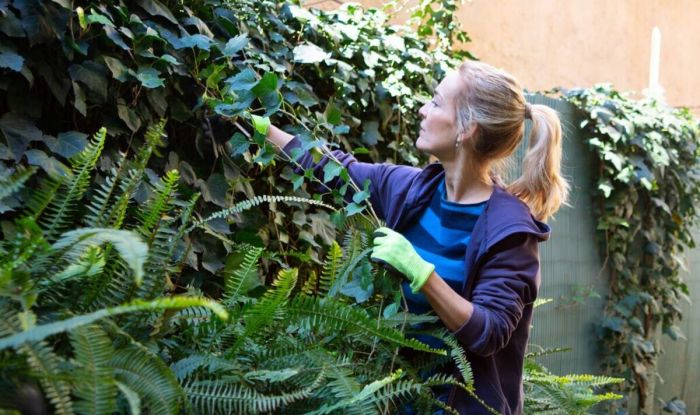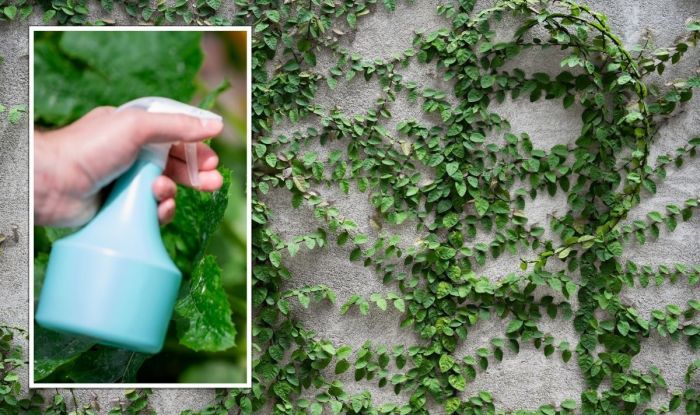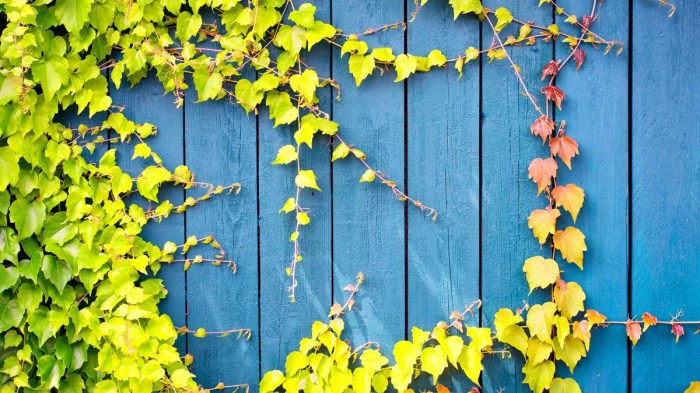How to get rid of ivy on a fence is a question many homeowners face. This tenacious vine can quickly engulf a fence, blocking sunlight, damaging the structure, and creating an unsightly mess. While ivy might look charming at first, it can quickly become a nuisance, especially when it starts to take over your property.
This guide will cover everything you need to know about tackling ivy on your fence, from manual removal techniques to chemical control options and preventative measures. We’ll also explore some natural remedies and alternative approaches, helping you choose the best method for your specific situation.
Understanding Ivy Growth and Impact: How To Get Rid Of Ivy On A Fence

Ivy is a tenacious plant that can quickly cover fences, walls, and other surfaces. Its clinging nature and rapid growth make it a formidable foe for homeowners seeking to maintain a tidy and attractive landscape. While ivy can add a touch of greenery to a property, it can also cause significant damage if left unchecked.
The Characteristics of Ivy That Make It Difficult to Remove
Ivy’s ability to thrive in various conditions and its persistent growth habits make it challenging to remove. Here are some key characteristics that contribute to its resilience:
- Aerial Roots:Ivy plants develop specialized aerial roots that attach themselves firmly to surfaces. These roots act like tiny suction cups, allowing the plant to cling tightly to walls, fences, and even trees.
- Rapid Growth:Ivy is known for its fast growth rate, enabling it to quickly cover large areas. Its rapid growth can overwhelm other plants and even damage structures.
- Adaptability:Ivy can tolerate a wide range of environmental conditions, including shade, drought, and poor soil quality. This adaptability allows it to thrive in diverse locations and makes it difficult to eradicate.
The Potential Damage Ivy Can Cause to Fences
While ivy may initially appear to be a harmless addition to a fence, its growth can lead to various problems:
- Structural Damage:As ivy grows, its roots can penetrate cracks and crevices in fences, weakening the structure and causing potential damage over time. The weight of the ivy itself can also put stress on the fence.
- Moisture Retention:Ivy can trap moisture against fences, creating a damp environment that can lead to rot and decay. This is particularly problematic in areas with high humidity or frequent rainfall.
- Blockage of Light and Airflow:Dense ivy growth can block sunlight and airflow to the fence, creating a dark and humid environment that can promote mold and mildew growth.
Examples of Different Ivy Species Commonly Found on Fences
Several ivy species are commonly found growing on fences. Here are a few examples:
- English Ivy (Hedera helix): This species is one of the most common types of ivy found in gardens and landscapes. It has distinctive dark green leaves and can grow quite aggressively.
- Boston Ivy (Parthenocissus tricuspidata): This species is known for its vibrant fall foliage, which turns a brilliant red or orange. Boston ivy can climb vertically and is often used as a decorative vine.
- Virginia Creeper (Parthenocissus quinquefolia): This species is similar to Boston ivy in appearance but has five leaflets instead of three. It can also climb aggressively and can damage structures if not controlled.
Manual Removal Methods

Manual removal is the most common and often the most effective method for getting rid of ivy from a fence. It involves physically removing the ivy from the fence, either by pulling it off or cutting it away. This method is labor-intensive but can be very rewarding, especially for smaller infestations.
Tools Needed for Manual Removal
The tools needed for manual removal will depend on the size and type of ivy, as well as the material of your fence. However, some basic tools are essential for most jobs.
Getting rid of ivy on a fence can be a bit of a chore, but it’s worth it for a cleaner look. If you’re dealing with stubborn ivy, consider using a combination of manual removal and a targeted herbicide.
Just be careful not to get any on your plants, as you might end up with a whole new problem – houseplant gnat infestation. Those pesky little flies can be a real nuisance, but with a little effort, you can get rid of them and enjoy your ivy-free fence.
- Heavy-duty gloves:These will protect your hands from scratches and thorns.
- Gardening shears or loppers:These will help you cut through thick ivy stems.
- Pruning saw:A pruning saw is helpful for cutting through thicker stems and branches.
- Hand trowel:A hand trowel is useful for digging up the ivy roots.
- Safety glasses:These will protect your eyes from flying debris.
- Long-sleeved shirt and pants:These will protect your skin from scratches and thorns.
Pulling Ivy From the Fence
Pulling ivy from the fence can be a good option for smaller infestations or for ivy that is not deeply rooted. To pull ivy from the fence, follow these steps:
- Start at the base of the ivy:Grab the ivy stems as close to the ground as possible.
- Pull firmly and steadily:Pull the ivy away from the fence, being careful not to damage the fence.
- Remove any remaining roots:Once the ivy is pulled away from the fence, use a hand trowel to dig up any remaining roots.
- Dispose of the ivy properly:Do not compost ivy, as it can easily re-root. Instead, bag it up and dispose of it in the trash.
Cutting Ivy From the Fence
Cutting ivy from the fence is a good option for larger infestations or for ivy that is deeply rooted. To cut ivy from the fence, follow these steps:
- Cut the ivy stems at the base:Use gardening shears or loppers to cut the ivy stems as close to the ground as possible.
- Remove any remaining stems and leaves:Once the ivy stems are cut, remove any remaining stems and leaves from the fence.
- Remove any remaining roots:Use a hand trowel to dig up any remaining roots.
- Dispose of the ivy properly:Do not compost ivy, as it can easily re-root. Instead, bag it up and dispose of it in the trash.
Preventing Re-Growth
Once you have removed the ivy from your fence, it is important to take steps to prevent it from re-growing. Here are some tips:
- Remove all remaining roots:Even small pieces of roots can re-grow into new plants.
- Apply a herbicide:A herbicide can help to kill any remaining ivy roots. Be sure to choose a herbicide that is safe for your fence and surrounding plants.
- Monitor the fence regularly:Check the fence regularly for any signs of re-growth and remove any new ivy plants as soon as they appear.
Chemical Control Options

Sometimes, manual removal methods may not be sufficient, especially when dealing with large infestations or dense ivy growth. In such cases, chemical control options can be a more effective solution. However, it is crucial to use herbicides responsibly and with caution to minimize potential harm to surrounding plants and the environment.
Herbicides Effective Against Ivy
Several herbicides are specifically formulated to control ivy. These herbicides are typically classified as either contact or systemic. Contact herbicides kill the ivy by direct contact, while systemic herbicides are absorbed into the plant’s vascular system, killing the entire plant, including roots.
- Glyphosate: A common, non-selective herbicide that is effective against a wide range of plants, including ivy. It is available in various formulations, including liquid concentrates and ready-to-use sprays.
- Triclopyr: A selective herbicide that targets broadleaf weeds, including ivy, while minimizing damage to grasses.
It is commonly found in combination with other herbicides, such as 2,4-D, to provide broader weed control.
- Dicamba: Another selective herbicide that is effective against ivy and other broadleaf weeds. It is often used in combination with other herbicides for broader weed control.
Getting rid of ivy on a fence can be a bit of a chore, but it’s worth it to restore your fence’s beauty. While you’re working on your fence, take a moment to appreciate the hummingbird migration that’s happening right now.
These tiny birds are amazing travelers, and they’re often attracted to gardens, so you might even spot one while you’re weeding out the ivy. Once your fence is ivy-free, you’ll have a beautiful backdrop for enjoying the sights and sounds of nature, including those fascinating hummingbirds.
Pros and Cons of Using Chemical Treatments on Fences
Using chemical treatments on fences presents both advantages and disadvantages.
- Pros:
- Effective Control: Herbicides can effectively kill ivy, even in difficult-to-reach areas.
- Time-Saving: Chemical treatments can be quicker and easier than manual removal methods, especially for large infestations.
- Cons:
- Potential Environmental Impact: Herbicides can harm non-target plants and wildlife if not applied carefully.
- Health Risks: Herbicides can be harmful to humans and pets if not handled properly.
- Potential Damage to Fence: Some herbicides can damage the fence material, especially if they are not applied correctly.
Safety Precautions for Applying Herbicides
It is essential to follow safety precautions when applying herbicides to ivy on a fence.
- Read and follow the label instructions: This includes information on dilution rates, application methods, and safety precautions.
- Apply on a calm day: Avoid windy conditions that could spread the herbicide to non-target areas.
- Wear protective gear: This includes gloves, long pants, a long-sleeved shirt, and eye protection.
- Avoid spraying near water sources: Herbicides can contaminate water sources and harm aquatic life.
- Keep children and pets away: Do not allow children or pets to enter the treated area until the herbicide has dried.
Prevention Strategies

The best way to deal with ivy on your fence is to prevent it from growing in the first place. This involves a combination of strategic fence design, proactive maintenance, and understanding the ivy’s growth habits. By implementing these strategies, you can minimize the chances of ivy becoming a persistent problem.
Fence Design for Ivy Resistance
A well-designed fence can act as a natural barrier against ivy encroachment. Here are some key design considerations:
- Solid Fence Panels:Solid fence panels, unlike lattice or picket fences, offer less surface area for ivy to cling to. They create a smoother surface, making it harder for ivy to establish itself.
- Smooth Fence Materials:Materials like vinyl, metal, or smooth-finished wood are less conducive to ivy growth. Ivy struggles to grip and climb these surfaces, reducing its chances of establishing itself.
- Adequate Spacing:Ensure adequate spacing between the fence and any nearby vegetation. This creates a buffer zone, preventing ivy from easily spreading from adjacent plants to the fence.
- Ivy-Resistant Plants:Consider planting ivy-resistant plants near your fence. These plants can compete with ivy for space and resources, making it harder for ivy to thrive.
Regular Maintenance for Ivy Control, How to get rid of ivy on a fence
Regular maintenance is crucial for preventing ivy from taking hold. This includes:
- Early Detection:Inspect your fence regularly for any signs of ivy growth. Early detection is key to preventing ivy from becoming a major problem.
- Prompt Removal:Remove any ivy shoots as soon as they appear. This prevents them from establishing roots and spreading further.
- Trim Back Overgrowth:Regularly trim back any trees or shrubs near your fence. This reduces the potential for ivy to use these plants as stepping stones to reach your fence.
- Clean Up Debris:Remove any fallen leaves or debris from around your fence. This prevents ivy seeds from finding a suitable place to germinate.
Alternative Approaches

While traditional methods like manual removal and chemical treatments are effective, they can be labor-intensive, environmentally impactful, or simply not suitable for everyone. Fortunately, several alternative approaches offer a more sustainable and eco-friendly way to tackle ivy infestations.
Natural Remedies for Ivy Control
Natural remedies can be an effective and environmentally friendly way to control ivy growth. These methods rely on the use of natural substances and techniques to inhibit ivy growth without resorting to harsh chemicals.
- Salt:Salt can be sprinkled around the base of the ivy plant to dehydrate it and inhibit growth. However, be cautious as excessive salt can harm nearby plants and soil.
- Vinegar:Vinegar is a natural herbicide that can be used to kill ivy. Spraying a mixture of vinegar and water directly onto the leaves can effectively kill the plant.
- Boiling Water:Pouring boiling water directly onto the ivy can effectively kill the plant. However, this method can also damage surrounding plants and soil.
- Mulch:Mulching around the base of the ivy plant can suppress its growth by blocking sunlight and creating a hostile environment for the plant.
Comparison of Ivy Removal Methods
Understanding the effectiveness and environmental impact of different ivy removal methods is crucial for choosing the best approach for your situation.
| Method | Effectiveness | Environmental Impact |
|---|---|---|
| Manual Removal | Highly effective, especially for small infestations | Low impact, but labor-intensive |
| Chemical Control | Very effective, but can have long-term effects on the environment | High impact, potential for soil and water contamination |
| Natural Remedies | Generally less effective than chemical control, but more environmentally friendly | Low impact, but may require more time and effort |
| Covering with Plastic Sheeting | Effective, but can be time-consuming | Low impact, but may require significant resources |
Covering Ivy with Plastic Sheeting
This method involves completely covering the ivy-infested area with a thick layer of plastic sheeting, effectively blocking sunlight and preventing photosynthesis. This can lead to the death of the ivy within a few weeks or months.
“Covering ivy with plastic sheeting is a simple and effective method, especially for large infestations. It is also a more environmentally friendly approach than chemical treatments.”
- Prepare the area:Clear any debris or obstacles from the area where the ivy is growing. Ensure the plastic sheeting can be spread out smoothly and securely.
- Secure the plastic sheeting:Use heavy objects like bricks, rocks, or landscaping timbers to hold the plastic sheeting in place. Ensure there are no gaps or openings for sunlight to penetrate.
- Monitor the ivy:Regularly check the ivy under the plastic sheeting. Once the ivy has died, remove the plastic sheeting and dispose of it properly.
Concluding Remarks

Conquering ivy on your fence doesn’t have to be a daunting task. With the right knowledge and tools, you can effectively remove this persistent vine and reclaim your fence. Remember, early detection and consistent maintenance are key to preventing ivy from taking hold in the first place.
By combining manual removal, chemical control, and preventative measures, you can create a beautiful and ivy-free fence for years to come.